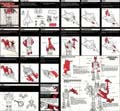Transformers came to its peak in 1986, but Hasbro had nearly exhausted licensable designs from other manufacturers, including old Takara toylines. Hasbro and Takara turned to unused Diaclone concepts and designs, such as the combiners. The Special Team Leader Silverbolt, a white Aérospatiale-BAC Concorde, was born from this development.
Origins
Silverbolt was originally conceptualized for a Diaclone subseries called “Jizai Gattai”, or Free Combination, which would have included the Stunticons, Combaticons, Aerialbots, Protectobots, and Metroplex. Each team had a theme, each limb figure could combine with any other team leader as any limb, and each leader figure had some sort of base mode, usually, with a spring-loaded vehicle launcher. All the figures could also interact with Metroplex. However, Transformers’ imminent success put Diaclone and Jizai Gattai on ice. It was Transformers’ long term success that saw these designs to completion, however. Silverbolt was invented by Koujin Ohno and the US Patent, titled Reconfigurable toy jet-plane (aka Transformers G1 Silverbolt) was filed on May 13, 1985 (U.S. Patent No. USD294049 S).
Description
Silverbolt transforms into a white Concorde SST. The airliner is molded in somewhat distorted proportions, and has blocky red, black, and gold-chrome parts under the wings and fuselage, necessary for the robot mode. The fuselage is lined with black and yellow stickers, aligning to the gold painted cockpit windows. He features retractable rolling front landing gear, and fixed rolling rear landing gear. He can transform into a “Launching Ramp” by turning the jet on its back, extending a pylon from the forward fuselage, and locking the robot’s legs around the wings. An included ramp accessory hitches over the leg hinge pin. The sliding red bar down the center of the jet is from a disabled spring-loaded vehicle launcher, omitted for safety reasons in the west. The Takara release still includes this feature, however.
Silverbolt's robot mode primarily comes from the large blocks hanging under his jet mode, and the tail, nose, and wings fold away on his back. His legs rotate down from the fuselage, while his arms and fists extend from under the wings. His robot head can be rotated up once the chest is slid down and the nose section rotated back. He is sometimes depicted with the jet-like white chestplate attached, but occasionally he is depicted without anything attached to his torso. He transforms to the torso of Superion by retracting his hands and pivoting his thighs outward. He then wears the Superion head over his, and the large winged chestplate and red waistplate are attached to his body.
Collector Notes
Silverbolt is highly prone to breakage in his leg hinges. The plastic parts that wrap around the long metal pin tend to crack, usually from the leg being forced back further than its natural stopping point. Alternately, the pin can work its way out of the hinge, simply causing the legs to fall off.
Variants
Silverbolt has only very minor production variations over the course of his run. Production was moved from Japan to Macau in 1987, resulting in very minor variations.
Availability
Slingshot was available individually boxed or in a Superion gift set in 1986. Due to the popularity of combiners, he was available again in 1987. He was available in 1990 in Europe’s continuation of G1.
Redecos & Retools
Silverbolt’s mold was used again in 1994 G2, in blue and silver with orange highlights.























